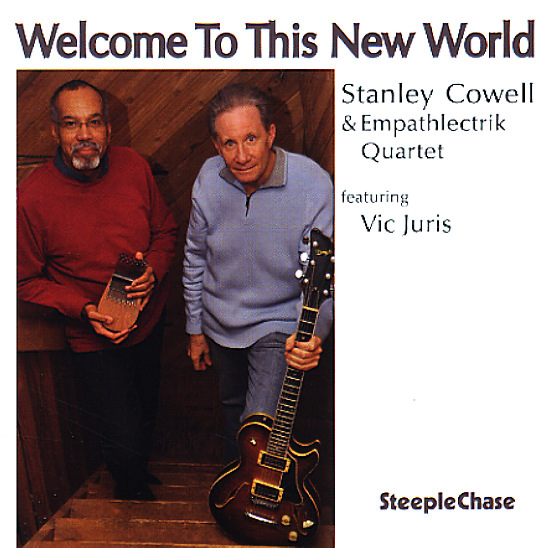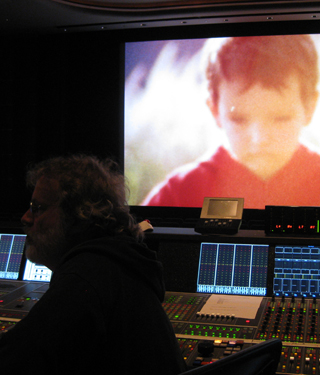
For the better part of a decade, jazz pianist/composer Stanley Cowell has become increasingly intrigued with the challenge of incorporating live electronics into the context of acoustic jazz — not electronics for its own sake — but electronics that add something meaningful to the music. In Cowell’s latest album, Welcome to This New World (SteepleChase SCCD 31757) he fully embraces the use of real-time signal processing and synthesis; Kyma has subtly infiltrated nearly every track “in ways that excite and disorient and offer a new dimension to improvisation,” to quote Chicago-based jazz reviewer Neil Tesser.
Welcome to This New World is a live album, no overdubbing, no post-production magic; every performance you hear on the album can be replicated on stage in real time… and will be this July 15 2013 at 7:30 pm in Hartford’s Bushnell Park at a free outdoor concert sponsored by the Hartford Jazz society and simulcast live on WWUH FM.
Cowell’s Empathlectrik Quartet features Vic Juris (guitar) and includes Tom DiCarlo (bass) and Chris Brown (drums), both of whom studied with Cowell at Rutgers. According to Cowell, Kyma acts as the fifth member of the Empathlectric Quartet.
AN OVERSEAS MEMORY eases you gently into the new world, with subtle, theremin-esque touches over jazz guitar, bass, piano. Relaxed yet precise, the music puts you by the water’s edge at sunset, with smooth dissolves through interesting rhythmic disintegrations and repeating downward major thirds.
By the time we arrive at track 2, TINGED, the coddling is officially over and we’re thrust into the brave new world, harmonically, rhythmically and timbrally. Each note is distorted by ragged amplitude modulation. The piano emits showers of particles and distorted accents in an easy BPM 90 with tricky beat displacements and slightly disorienting live pitch bending.
VICTIM is fun, fast and boppish (16th notes at BPM 60?), the piano processing takes on a vocal quality that sounds like spectral voices. Some of the solos venture into territory heard only at electro-acoustic music concerts. A guitar solo is doubled by a delayed, ghost guitar, and the piano stabs sounds, at times, completely electronic. The abrupt ending sizzles into a noise decay.
Jazz critic Neil Tesser describes describes VICTIM as “instantly traversing the gulf between post-boppish improvisation and post-post-modernism”. Yeah! With another “post” thrown in for good measure!
The exquisite DUO IMPROVISATION I is just piano and guitar processed through Kyma. The entire track is filtered through a time-stretched vocoder/RE on the spoken phrase: “We pray for peace”, repeating and elaborated through metric and harmonic modulations. On this track, Kyma functions as a third performer: a prism through which you hear the other two performers! Fluid and ever-changing, the phrase morphs into an insistent invocation for peace, before easing back into a contemplative ending. Reflective, haunting and beautiful, this track bears repeated listening to appreciate just how musically innovative it really is.
EMPATHLECTRIK is a Cowell neologism derived from “Empathy + Electric”. In this track, Kyma sounds are incorporated into the theme itself and, as Tesser observes, Kyma “enhances the improvisation without overwhelming it.” The piano moves in and out of subtle modulation, there are theremin-like touches on the guitar, arpeggiated piano clusters pitch-shifted up. It sounds like it’s been multi-tracked and processed, but it’s all live! The New World has arrived.
Live spectral analysis and resynthesis of the piano through the Kyma CloudBank provides shimmery prolongations of the guitar and piano pitches in INVERTISEMENT. A sudden shift to the dry piano sounds sounds so focused and new; it makes you realize that hearing the processed piano lets you hear the dry piano with new ears; you no longer take any sound for granted.
During the unprocessed interludes, you have a chance to reflect on and appreciate the economy and precision of Cowell’s playing. Complex and masterful, his playing remains disciplined and focused, even when veering off into timbral new worlds. There’s never an extraneous note or gratuitous ornament. Similarly, the seeming ease with which Juris’ fingers fly over the fingerboard evidences a calm serenity that can only come from years of practice and total mastery.
This track, like the others, is formally solid, notwithstanding the wild timbral excursions.
After the solos, a reprise of the shimmery clouds. The reason these electronics feel so organic is precisely because they emerge entirely from the acoustic performance. They’re not played on a sequencer or a synthesizer, they are played on a real acoustic piano and subtly processed through the electronics. Thus, the resulting sound feels totally different from a synthesized track.
Picking up the pace and the mood again is SUN BURN which Neil Tesser describes as “shades of Weather Report”. The piano resynthesis has a decidedly vocal flavor, suggesting a female vocalist doubling the piano. This would be a good one to listen to while cruising down the highway and includes a rock-worthy drum solo.
In DUO IMPROVISATION II, you are suspended, drifting through space, with gentle electronics and atmospheric processing. Washes of quick arpeggios and Debussy-esque scales are held together by a subtle G pedal drone.
ST CROIX opens with cheery island percussion and ostinati. Bubbly, liquid processing alternates with straightforward sections and the metallic overtones of an acoustic thumb piano, this is one to listen to through ear buds while strolling down summer streets downtown.
With WINTER REFLECTIONS, the desolation of winter returns. Dry snow swirling like dust across dark streets, and shivery scraping on piano strings and cymbals coalesce into the theme stated in guitar and conversationally commented on by the piano. A slightly melancholic piano solo w/ tremolo, recovers with a strong bass line leading into the next chorus. There’s a delightfully high-pitched, fast bass solo with some light touches from electronics, a reprise of solo in guitar with piano commentary, and it ends with piano string-scraping and thermin sounds.
WELCOME TO THIS NEW WORLD features octave doubling, unisons, swinging syncopations, subtly warped resynthesis and disorienting non-sinusoidal resynthesis that gives the piano a harpsichord-like quality. The Theremins and piano wire scrapes return. By now we are solidly in the new world.
Stanley Cowell and Kyma
 Cowell’s fascination with electronic music was first ignited when, as a sophomore at Oberlin College, he heard a lecture by Karlheinz Stockhausen. Cowell was struck by Stockhausen’s observation that once any music is recorded, it becomes electro-acoustic music. Cowell kept coming back to that idea, throughout the 1960s as a jazz performer and into the 1980s as he turned more toward composition. It wasn’t until 1997 when, as a professor at Lehman College in New York, he had an opportunity to write a grant to purchase one of the early Kyma systems.
Cowell’s fascination with electronic music was first ignited when, as a sophomore at Oberlin College, he heard a lecture by Karlheinz Stockhausen. Cowell was struck by Stockhausen’s observation that once any music is recorded, it becomes electro-acoustic music. Cowell kept coming back to that idea, throughout the 1960s as a jazz performer and into the 1980s as he turned more toward composition. It wasn’t until 1997 when, as a professor at Lehman College in New York, he had an opportunity to write a grant to purchase one of the early Kyma systems.
He’s been using Kyma in his music ever since, but it wasn’t until the new, more portable, Paca was released that he began taking it on the road. “It’s a sound design workstation,” Cowell says of Kyma, differentiating it from other computer programs or electronic keyboard instruments, “basically, if you look at every real-time device that does something to sound, Kyma does all of that.”
During the recordings (and in live performances) Cowell sends the guitar signal to the left Kyma input and piano signal to the right input. Juris has his own foot controllers, while Cowell controls and initiates Kyma Sounds from his MacBook Pro. (Bass and drums are not processed). The result is like nothing you have heard before. Yet it never loses its grounding in acoustic jazz. Welcome to This New World is new music that sounds like nothing you’ve heard before.
 “Working from a script shaped more by sound than words, insight comes at us in primal waves. The heart-wrenching sobs, the gut-churning nausea, the keening and, perhaps most profound of all, the silence. It all carries specific meaning.”
“Working from a script shaped more by sound than words, insight comes at us in primal waves. The heart-wrenching sobs, the gut-churning nausea, the keening and, perhaps most profound of all, the silence. It all carries specific meaning.”
 Cowell’s fascination with electronic music was first ignited when, as a sophomore at Oberlin College, he heard a lecture by Karlheinz Stockhausen. Cowell was struck by Stockhausen’s observation that once any music is recorded, it becomes electro-acoustic music. Cowell kept coming back to that idea, throughout the 1960s as a jazz performer and into the 1980s as he turned more toward composition. It wasn’t until 1997 when, as a professor at Lehman College in New York, he had an opportunity to write a grant to purchase one of the early Kyma systems.
Cowell’s fascination with electronic music was first ignited when, as a sophomore at Oberlin College, he heard a lecture by Karlheinz Stockhausen. Cowell was struck by Stockhausen’s observation that once any music is recorded, it becomes electro-acoustic music. Cowell kept coming back to that idea, throughout the 1960s as a jazz performer and into the 1980s as he turned more toward composition. It wasn’t until 1997 when, as a professor at Lehman College in New York, he had an opportunity to write a grant to purchase one of the early Kyma systems.

